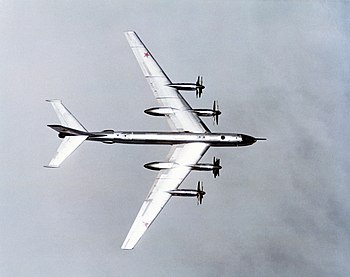 |
The design bureau led by Andrei Tupolev designed the Soviet Union's first intercontinental bomber, the 1949 Tu-85, a scaled up version of the Tu-4, a Boeing B-29 Superfortress copy.
The Tu-95/I, with 2TV-2F engines, first flew 11 November 1952 with test pilot Alexey Perelet at the controls. The second aircraft, Tu-95/II featured four of the 12,000 ehp Kuznetsov NK-12 turboprops which proved more reliable than the coupled 2TV-2F. After a successful flight testing phase, series production of the Tu-95 started in January 1956.
For a long time, the Tu-95 was known to U.S./NATO intelligence as the Tu-20.. While this was the original Soviet Air Force designation for the aircraft, by the time it was being supplied to operational units it was already better known under the Tu-95 designation used internally by Tupolev, and the Tu-20 designation quickly fell out of use in the USSR.
Like its American counterpart, the Boeing B-52 Stratofortress, the Tu-95 has continued to operate in the Russian Air Force while several subsequent iterations of bomber design have come and gone. An AWACS platform (Tu-126) was developed from the Tu-114. An icon of the Cold War, the Tu-95 has served not only as a weapons platform but as a symbol of Soviet and later Russian national prestige.


No comments:
Post a Comment